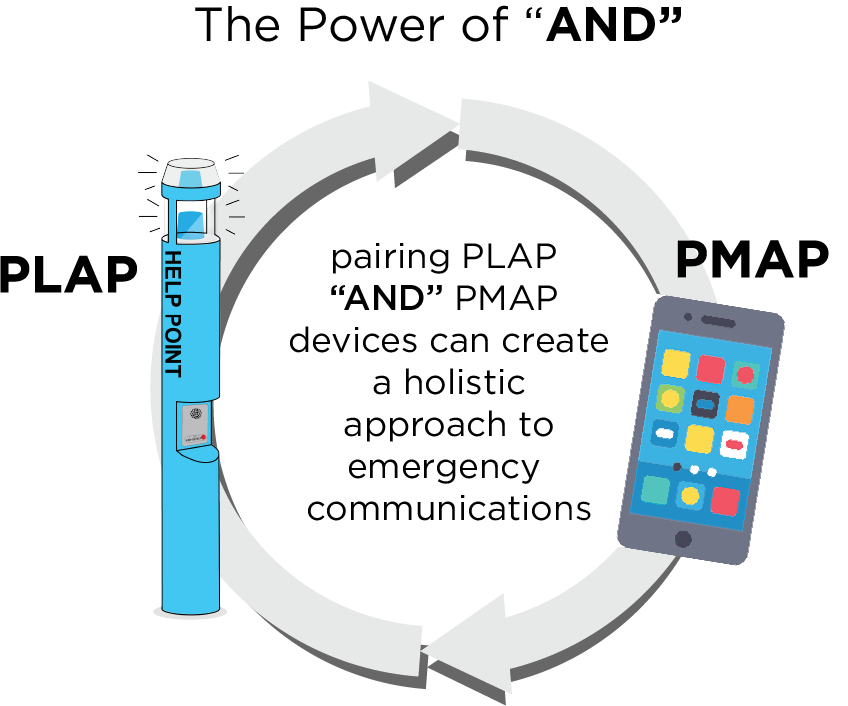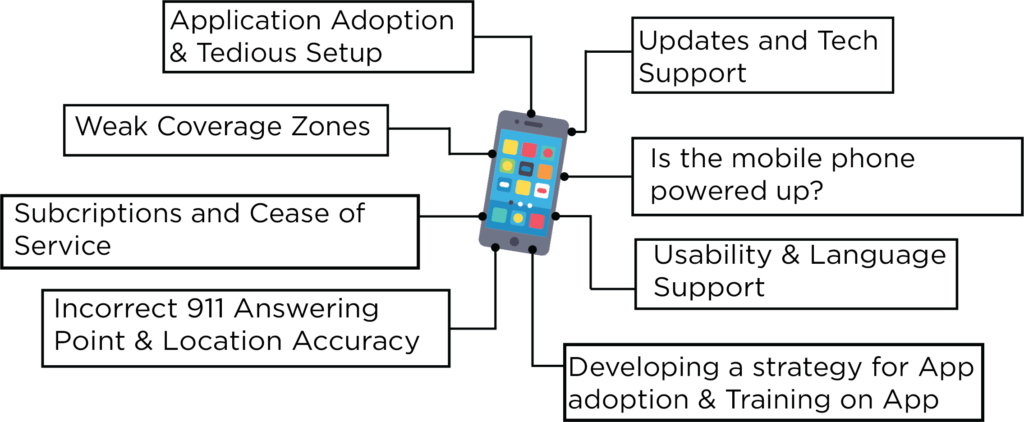EMERGENCY COMMUNICATIONS SERIES

The Power of “AND” Regarding Human Engagement through Physically Located Access Points (PLAP) and Physical Mobile Access Points (PMAP)
Download this post in PDF format here:

Emergency Communications – PLAP + PMAP Human Engagement
The Code Blue Emergency Communications Series will help System Integrators and Customers understand the importance of robust communication systems during emergencies.
This edition focuses on aspects of Code Blue’s perspectives and considerations around human engagement in emergency situations. Customers can benefit from understanding the big picture of why PLAP and PMAP devices and their collective attributes should become part of an overall solution.
Please remember that Code Blue is always ready to help with any questions regarding our solutions. No one should feel like they are on an island. Together, we are a community dedicated to assisting Public Safety save lives!
A Combined Architecture
Using PLAP and PMAP devices for emergency communications can offer a broader range of human interaction and presence for peace of mind.
Given a specific design, operational plan, and environment testing of a combined architecture, especially for PMAP and APPS (see herein), other advantages might include:
Resilience:
In emergency situations, communication networks may become disrupted. Having both PLAP and PMAP devices might ensure greater resilience. If one becomes inoperative due to power failures, line outages, or network issues, the other may continue to function and provide vital information.
Real-Time Monitoring and Alerts:
Both types of devices enable real-time monitoring, which is essential in emergency situations.
Enhanced Situational Awareness:
Combining PLAP and PMAP devices can provide a more comprehensive picture of an emergency situation, leading to more informed decision-making. The following chart represents the concepts of a combined architecture for PLAP and PLMP devices within the Code Blue Emergency Communications Ecosystem.

Starting with a Baseline
Proven:
Code Blue PLAP Help Points combined with Nebula Cloud can continuously monitor, analyze, and route response notifications for specific locations in public buildings, campus grounds, parking facilities, and other structures. Public safety command operators are informed in real time to engage first responders. Code Blue has decades of experience and innovations, all driven by customers.
Pinpoint Location:
First responders can determine your whereabouts instantly with blue light PLAPs.
Reliability:
Blue light PLAPs eliminate human error by making it simple: Push the button, alert first responders, and receive assistance.
Integrations:
Many other solutions can be added to the PLAP and Nebula operating picture – Video recording, automation (gates, lights, signs), paging, mass notification software, and IoT Sensors (gunshot, CO2, flood, vibration, intrusion, and AED boxes). Additional services on campus might be non-emergency or information-related – mapping, service requests, and visitor information.
Deterrence and Expectations:
Clearly, PLAPs can help deter crimes, and they are frankly expected as a standard – a few points from an article published by Campus Safety Magazine.
“Blue Light Phones Deter Crime – A study of 422 incarcerated burglars found that window and lawn signs indicative of security measures put in place are an effective way to deter burglary attempts. One of the most valuable aspects of a blue light phone is its ability to increase the awareness of on-campus security measurements.
Rice University in Houston, Texas, once had a stained history of criminal incidents, similar to the city of Houston’s high crime rate. However, after Rice installed 80 blue light emergency phones in 2010, the following year, the school reported that the overall crime rate on campus decreased despite the city of Houston’s crime rate remaining high. Specifically, on-campus burglaries plummeted by 67.74%.
As the number of blue light phones increased, the perception and awareness of the campus’ security also increased, deterring the number of on-campus burglaries from being attempted.
If 19 out of 20 colleges have emergency blue light phones, the one school that lacks emergency phones is immediately at a disadvantage regarding perceived security.”
Peace of Mind and Familiarity:
Most importantly, people (students, parents, employees, contractors) in such environments instantly know what a PLAP Help Point is for and how to use it, ensuring their means to communicate with authorities that operate emergency communications systems. PLAPs are widely known to be deterrents because they are immutably and intuitively recognized as points of safety.
Extending Value – App and mobile solution segment (PMAP) within a combined architecture requires specific risk awareness, planning, and countermeasures.
PMAPs (APPs and mobile phones) are complimentary and help to extend the human factor regarding the choice of engagement. They can move with individuals or vehicles, offering dynamic coverage and the ability to relay information from various locations, including areas outside the reach of fixed devices.
There are a few risks with APPs and mobile phones that must be understood. This is to ensure that a combined solution operates as intended.
APP Adoption
Although sources can’t be disclosed, Code Blue has learned over the years that adoption rates for emergency communications APPs on campus are very low.
Here, we find an enterprise-related perspective on adoption, as communicated by UNQORK – “According to the latest statistics, user adoption rates for enterprise applications are low across the board. In fact, SAP found that 78% of mobile apps are abandoned after only a single use, and web applications and software don’t fare much better. In the financial services industry, for example, only 38% of users return to an application after the first day. Only 5% of those users are active after a full 30 days. For software as a service (SaaS), these adoption rates are even worse. According to research conducted using anonymized data from 1.3 billion unique users, the average SaaS eight-week user retention rate hovered in a disappointing 6-20% range.”
More Matters Must be Addressed in an APP Operations Plan

- Developing a strategy for APP adoption.
- Training on the APP to help people (e.g., students) to simulate real use; otherwise, people can fumble to find an APP, unlike engrained knowledge of a PLAP.
- Is the mobile phone powered up?
- Identify weak coverage zones for Wi-Fi and cellular coverage.
- APP updates.
- Testing for location accuracy.
- APP setup instructions for a certain deployment (notifications, features to use or not use).
- Technical support.
- Subscriptions and cease of service.
- Language support – many institutions embrace diversity – APPs have to accommodate some level of translation, whereby just “hitting the button” is universally understood.
- Procedures for visitors, families, vendors, etc.
- 911 direct calling may end up at the wrong LE answering point.
BOTTOM LINE
Hopefully, you see why PMAP is not a holistic solution and should be considered an added value for a PLAP-based solution – a combined architecture.
By combining PLAP and PMAP devices for human engagement in emergency communication systems, customers can leverage both to create a more robust, responsive, and comprehensive emergency response network. This combined approach enhances safety and preparedness in various emergency scenarios. Operational planning is a very important aspect of PMAP deployments.
We hope the Code Blue Team has helped you better understand emergency communications solutions. Please consider contacting Code Blue for help (https://codeblue.com/contact) to make your Code Blue Solutions come to life!
